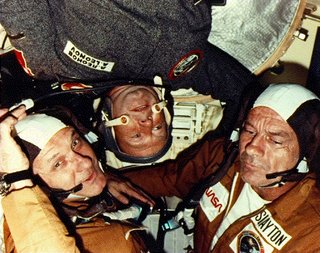 Today I attended a lecture about women pilots in Germany during World War II. On the projection screen at the front of the room, the lecturer showed us photo after photo of these women. Some wore tight leather fighter caps and goggles on their foreheads. Others posed with their dark hair blowing in the wind, a wide grin painted on their unlined faces. And others stood next to heavy silver planes---"Hitler's Flying Floozies," as the lecturer joked.
Today I attended a lecture about women pilots in Germany during World War II. On the projection screen at the front of the room, the lecturer showed us photo after photo of these women. Some wore tight leather fighter caps and goggles on their foreheads. Others posed with their dark hair blowing in the wind, a wide grin painted on their unlined faces. And others stood next to heavy silver planes---"Hitler's Flying Floozies," as the lecturer joked. As I listened to the talk, I thought about the National Air and Space Museum, the place where the lecture was held and also the place where I work. Half of my museum is dedicated to aviation (thus Air and Space) and a significant portion of this half focuses on war planes. Combat aircraft can be found all over NASM---suspended from the ceiling or resting snugly on the museum floor. These planes are pretty artifacts, often painted red or green or polished to a shiny silver. Hundreds of visitors pose in front of them every day. "Look at this, son," they say before snapping a picture, "this plane was used in World War I. Your great-grandpa fought in that war."
So much romanticism enshrouds war-time aviation. Daredevil pilots with handsome smiles, tough little planes with colorful emblems, acrobatic manuevers through the cobalt sky. Oftentimes the romanticism is so thick that we forget the noisy engines and the faulty mechanics, the hazardous conditions and the casualty rate.
 Or we overlook the countless widows and widowers who have lost a spouse or the numberless children who have lost a parent.
Or we overlook the countless widows and widowers who have lost a spouse or the numberless children who have lost a parent. War is ugly, but it doesn't seem that way when you walk through a big friendly museum like Air and Space. It doesn't help that the museum primarily focuses on the technological aspects of aviation, rather than the social consequences of these devices. You'll never find a tally besides each plane that tabulates how many people were killed by the very artifact you're taking a picture of. That wouldn't make for a good photograph.
I'm not saying that airplanes are bad or even that war is bad. Planes have good uses as well as bad uses and the same thing goes for war. A war can be just or unjust and it can also be fought justly or unjustly. War is too complicated to be pigeonholed as either right or wrong.
But right or wrong, just or unjust, I find war to be terribly depressing. No matter how noble the cause, war causes families to be torn apart, homes to be destroyed, cities to be ripped asunder, and nations to be crushed. The War in Iraq has brought chaos to the Iraqi people; the recent Israeli attacks in Lebanon have killed over one-hundred people in a few days. And in Sudan, thousands of people are being murdered. Women are raped; men are killed; children are left orphans.
It makes me sad that war has become a normal part of life. It makes me sad that war has regularly stained human history. And it makes me sad that the dream of world peace is indeed only a dream.
At the Air and Space Museum, located a few hundred feet from the war planes, there sits a replica of the Apollo-Soyuz mission. Back in the seventies, an Apollo spacecraft docked with a Russian Soyuz vessel in space. Once the docking procedure was complete, the astronauts floated into each other's ships and shook hands. Some historians say that the Apollo-Soyuz mission was a tremendous step forward in establishing good relations with the USSR. I would agree. Apollo-Soyuz represented two enemies coming together and enjoying one another's company. No threats, no weapons, no war---just a firm handshake and a smile.
I can only wish that we had more artifacts like this in my museum.

